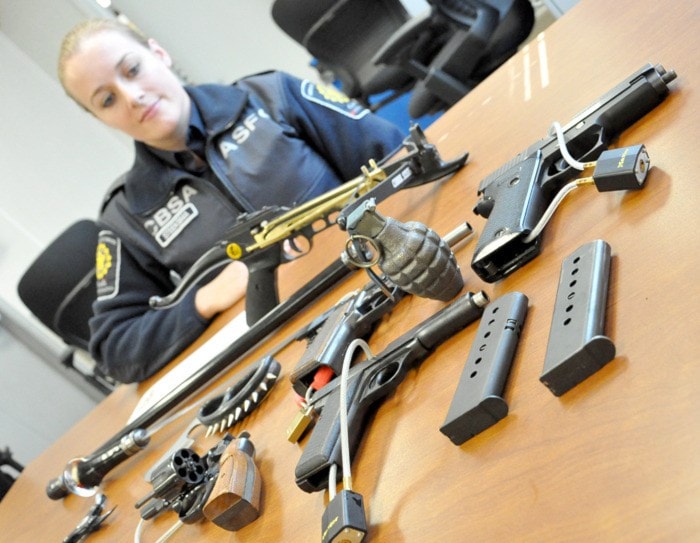The table holds a seemingly random assortment of guns, blades, a grenade and a few obscure pieces. But they all have one thing in common: They were seized at the Kingsgate border crossing in the last six months.
Seizures of firearms and weapons increased — for no apparent or identifiable reason — at the Kingsgate port of entry in the past year, with 14 from September 2009-September 2010 to 19 from September 2010-September 2011.
At the Rykerts crossing, just south of Creston, there were six seizures of prohibited goods and weapons, including firearms, between April 2009 and April 2010, but only one between April 2010 and April 2011. Each seizure may include one or several items.
The weapons may be seized for a variety of reasons, said Canada Border Services Agency spokesperson Erin Steeksma, community public affairs officer — a pilot project position that started in August — for the CBSA’s Pacific region, which includes B.C. and the Yukon.
U.S. residents, for example, may be used to having a weapon in the vehicle and forget it’s there when questioned by CBSA officers. Others are prohibited, while some were intentionally unclaimed, even though they may have been permitted.
“There are more ways for us to help you if you declare them,” said Steeksma, a seven-year CBSA veteran who toured the southern B.C. border crossings last week, visiting Kingsgate on Sept. 29.
And the grenade, while unnerving, fortunately isn’t as volatile as it looks.
“A lot of times they are just inert ones that come through,” Steeksma said.
A recent seizure at Kingsgate took place on Sept. 8 when officers inspected the vehicle of a U.S. resident, who had admitted to having pepper spray. During the inspection of the vehicle, officers discovered a second can of pepper spray and a gun holster, which led to a more intense search that turned up three prohibited, loaded handguns and a high-capacity magazine. The weapons and vehicle were seized. Criminal charges are pending, and so far, the traveller has paid over $4,000 in penalties.
Weapons aren’t the only prohibited items that travellers attempt to bring across the border.
“We also get a lot of seizures related to undeclared narcotics,” said Kingsgate Supt. Brad Berdusco.
There were 43 narcotics seizures at the Kingsgate crossing from September 2009-September 2010 and 51 from September 2010-September 2011. At the Rykerts crossing, there were 14 narcotics seizures from April 2009-April 2010, and four from April 2010-April 2011. As with weapons, each seizure may include multiple items.
Weapons and narcotics seizures may be the most tantalizing offenses to hear about, but they are far from the most common infraction border guards come across.
With the Canadian and U.S. dollars so close to parity, online shopping has seen an increase. But many packages — perhaps 80 per cent, said Steeksma — often don’t contain a receipt, which can make it difficult to bring the product back to Canada.
“[Online shoppers] expect there to be a receipt or invoice in the box,” said Steeksma. “The majority of the time ... there’s no receipt.”
If a parcel can’t be cleared without the receipt, it may be refused entry, necessitating a second trip to the border — this time with the receipt.
Steeksma said that another concern is the misinformation passed on by travellers who don’t pay taxes or duties on items purchased on a day trip or if they are over their allowed limit. Personal exemptions are $50 for an absence of 24 hours or more, $400 for 48 hours and $750 for seven days.
“The law says that tax should be paid with no exceptions,” said Steeksma.
But if the officers at the crossing are involved in a seizure or arrest, there’s a good chance travellers will be waved through without having to pay.
“For their safety, we won’t send them in for that,” she said.
One of the best ways for travellers to make their crossing easier is to have receipts — both for purchases and hotels — ready to show border guards as they re-enter Canada. As well, identification should be kept handy before arriving at the port of entry.
“We still get some people who hop out of their car to get their passport out of the trunk,” said Steeksma.
And above all, do some research before you leave the country.
“It is important for travelers to educate themselves before they travel, or ‘know before you go,’ ” said Steeksma. “By being aware of exemption limits and restrictions, both visitors and residents of Canada can avoid unnecessary delays. In some cases, seizures and penalties can result from failing to declare goods properly.”
For more information on crossing the Canada-U.S. border, visit www.cbsa.gc.ca or contact the Border Information Service line at 1-800-461-9999 (204-983-3500 outside of Canada).
